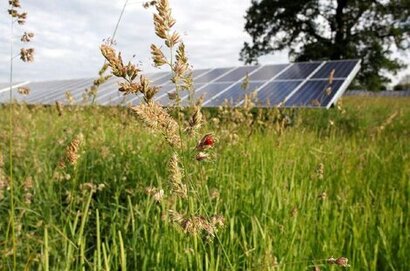
Both hares and skylarks are vulnerable species, with skylarks – iconic for their springtime singing – being red-listed following dramatic declines in population over recent times. A total of 279 individuals were seen across the 87 sites surveyed last year as part of the study.
The brown hare, a species of conservation concern, made up 40 percent of mammal observations. Other mammals including badger, fox, rabbit, weasel, common shrew, field vole and three types of deer. The findings are most likely an underestimate, as field surveys were performed at times when they are less likely to be active.
The small heath butterfly, a species of principal importance for biodiversity conservation that has fallen in number across the UK, was found at ten sites. Other scarce species included the amber-listed Dartford warbler and the red-listed tree pipit, with the legally-protected common rosefinch – a rare visitor to the UK – making a surprise appearance.
The key message of the report is that solar farms can become havens for biodiversity, playing an important role in nature restoration across the country.
The more diverse the plant species found, the more invertebrate species were found. In turn, invertebrate diversity has a positive relationship with bird species.
The survey was They employed a standardised methodology developed by them, Solar Energy UK and Lancaster University in 2022. A total of 50 more sites were analysed than during the initial survey. The sites’ geographical distribution broadly reflects that of the industry as a whole.
However, the new data is not wholly comparable to that from the first report, as biodiversity monitoring is not always conducted annually on each site, and the time of year and the weather can also influence the results. Given time, we hope to accumulate information from the same locations taken over multiple years, allowing the exploration of trends and changing management practices. We are hopeful that the methodology will be used by more ecological consultancies and be applied across more solar farms in future years, as demand for monitoring grows and the solar sector steadily expands. Gathering data from more sites means that we can ascribe greater confidence to our findings.
Nevertheless, the new results are even clearer that efforts to promote biodiversity are paying off. The number of plant species found was significantly greater on sites managed specifically with biodiversity in mind: with conservation mowing or grazing, removal of arisings and with a range of habitats present. The relationship was even clearer for invertebrates, while there were also positive relationships established between the diversity of plant and bird species, and between the abundance of birds and invertebrates.
Such knowledge provides more than environmental benefits. It could also be economically beneficial to the sector, while providing an incentive to improve habitat management. A separate study of ten solar farms, also disclosed in the report, found that measures such as building ponds, tree planting and enhancing existing hedges could increase biodiversity by 8-110 percent, as measured by the Government’s biodiversity net gain (BNG) framework. Regulator Natural England is using this research to apply BNG to solar farms, with a case study to follow later this year.
The regime entered into force last month, requiring major developments to deliver an increase in biodiversity of at least 10 percent, either on site, off-site, or through buying biodiversity credits.
But solar farms have the potential to deliver far more than the statutory minimum rise in biodiversity. While there may be minor loss in habitat due to the construction of access tracks, mounting frames and substations, land take can be as little as 2 percent of the total area of the development, with panels covering around 40 percent.
“Our understanding of biodiversity at solar farms is growing as more ecological monitoring data are collected across an increasing number of UK solar farms” said report analyst Hollie Blaydes, PhD Researcher at Lancaster Environment Centre, Lancaster University. “Groups such as birds and invertebrates appear to respond positively to biodiversity-focused management at solar farms and we hope to continue working with the data to further unpick the patterns identified.”
The findings are bolstered by the first peer-reviewed scientific paper on insect pollinators on UK solar farms, published last month in the journal Ecological Solutions and Evidence with authors including Blaydes. Led by Lancaster University, in collaboration with the University of Reading, the study covers 15 sites surveyed over 2021.
“We are delighted to see yet more data demonstrating the vital role that solar farms are playing in nature recovery” added Chris Hewett, Chief Executive of Solar Energy UK. “Solar Energy UK is committed to working with the industry to build this evidence base year on year.”
It found that boosting the diversity of flowering plant species is a key way to increase the abundance and diversity of bumblebees, butterflies and hoverflies, with the number of flowering plants being less important than their variety. Solar farms can also provide vital islands of biodiversity in landscapes that otherwise have little to offer wildlife, said the paper.
The Solar Energy UK report includes a series of case studies.
Using eDNA: For the first time, environmental DNA – traces of genetic material left by wildlife – has been used to assess the presence of vertebrates on solar farms. Although the technique cannot always identify wildlife to the level of individual species, it does provide a way to establish the presence of elusive wildlife such as polecat, harvest mouse and otter.
Growing shade-tolerant wildflowers: Planting plugs and pot-grown plants under the panels was found to be much more successful than sowing seeds, with up to 80 percent of plants surviving after two years. Wild garlic and bluebell grew best, with lesser celandine and wood anemone doing less well. All four species provide a glorious display of spring flowers, offering vital nectar for insects.
Growing chamomile: A trial found that it is possible to grow commercial yields of annual chamomile between panel rows – an application of the ‘agri-PV’ concept.
For additional information:

